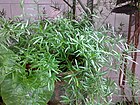Note: This is a project under development. The articles on this wiki are just being initiated and broadly incomplete. You can Help creating new pages.
Difference between revisions of "Asparagus adscendens"
| (2 intermediate revisions by the same user not shown) | |||
| Line 1: | Line 1: | ||
[[File:Asparagales - Asparagus adscendens - 2.jpg|thumb|right]] | [[File:Asparagales - Asparagus adscendens - 2.jpg|thumb|right]] | ||
| + | '''Asparagus adscendens''' is a perennial usually climbing plant. | ||
| + | It is a famous Ayurvedic medicinal herb. it is said to be particularly useful as a women's herb. It is commonly harvested from the wild to the extent that over collection in some areas of its range are causing conservation concerns. | ||
==Uses== | ==Uses== | ||
| − | {{Uses|}}, {{Uses|}}, {{Uses|}}, {{Uses|}}, {{Uses|}}, {{Uses|}}, {{Uses|}}, {{Uses| | + | {{Uses|Infertility}}, {{Uses|Loss of libido}}, {{Uses|Threatened miscarriage}}, {{Uses|Menopausal problems}}, {{Uses|Hyperacidity}}, {{Uses|Stomach ulcers}}, {{Uses|Bronchial infections}}, {{Uses|Dysentery}}. |
==Parts Used== | ==Parts Used== | ||
| − | {{Parts Used| | + | {{Parts Used|Tender young shoots}}. |
==Chemical Composition== | ==Chemical Composition== | ||
| − | <ref name="chemical composition"/> | + | Asparagus species (family Liliaceae) are medicinal plants of temperate Himalayas.<ref name="chemical composition"/> |
==Common names== | ==Common names== | ||
| Line 16: | Line 18: | ||
===Dravya=== | ===Dravya=== | ||
===Rasa=== | ===Rasa=== | ||
| − | |||
===Guna=== | ===Guna=== | ||
| Line 29: | Line 30: | ||
==Habit== | ==Habit== | ||
| − | {{Habit|}} | + | {{Habit|Perennial}} |
==Identification== | ==Identification== | ||
| Line 48: | Line 49: | ||
==Mode of Propagation== | ==Mode of Propagation== | ||
| − | {{Propagation|}} | + | {{Propagation|Seeds}} |
==How to plant/cultivate== | ==How to plant/cultivate== | ||
| − | <ref name="How to plant/cultivate"/> | + | Found in the subtropics to tropics, but usually avoiding the wetter regions. It requires a distinct dry season in order to flourish.<ref name="How to plant/cultivate"/> |
==Commonly seen growing in areas== | ==Commonly seen growing in areas== | ||
| − | {{Commonly seen|}}, {{Commonly seen|}}, {{Commonly seen| | + | {{Commonly seen|Himalayas}}, {{Commonly seen|Eastwards from Kashmir}}, {{Commonly seen|Broad-leaved forests}}. |
==Photo Gallery== | ==Photo Gallery== | ||
| Line 65: | Line 66: | ||
==References== | ==References== | ||
| − | |||
<references> | <references> | ||
| − | <ref name="chemical composition">[ | + | <ref name="chemical composition">[https://www.ncbi.nlm.nih.gov/pmc/articles/PMC3249924/ Chemistry]</ref> |
| − | + | <ref name="Leaf">[Morphology]</ref> | |
| − | <ref name="Leaf">[ | + | <ref name="How to plant/cultivate">[Cultivation]</ref> |
| − | |||
| − | <ref name="How to plant/cultivate">[ | ||
</references> | </references> | ||
==External Links== | ==External Links== | ||
| − | * [ ] | + | * [https://www.intechopen.com/books/phytochemicals-in-human-health/medicinal-properties-of-selected-asparagus-species-a-review Asparagus adscendens on intechopen.com] |
| − | + | ||
| − | |||
[[Category:Herbs]] | [[Category:Herbs]] | ||
| − | |||
Latest revision as of 12:13, 30 March 2020
Asparagus adscendens is a perennial usually climbing plant. It is a famous Ayurvedic medicinal herb. it is said to be particularly useful as a women's herb. It is commonly harvested from the wild to the extent that over collection in some areas of its range are causing conservation concerns.
Contents
- 1 Uses
- 2 Parts Used
- 3 Chemical Composition
- 4 Common names
- 5 Properties
- 6 Habit
- 7 Identification
- 8 List of Ayurvedic medicine in which the herb is used
- 9 Where to get the saplings
- 10 Mode of Propagation
- 11 How to plant/cultivate
- 12 Commonly seen growing in areas
- 13 Photo Gallery
- 14 References
- 15 External Links
Uses
Infertility, Loss of libido, Threatened miscarriage, Menopausal problems, Hyperacidity, Stomach ulcers, Bronchial infections, Dysentery.
Parts Used
Chemical Composition
Asparagus species (family Liliaceae) are medicinal plants of temperate Himalayas.[1]
Common names
| Language | Common name |
|---|---|
| Kannada | |
| Hindi | |
| Malayalam | |
| Tamil | |
| Telugu | |
| Marathi | |
| Gujarathi | |
| Punjabi | |
| Kashmiri | |
| Sanskrit | |
| English |
Properties
Reference: Dravya - Substance, Rasa - Taste, Guna - Qualities, Veerya - Potency, Vipaka - Post-digesion effect, Karma - Pharmacological activity, Prabhava - Therepeutics.
Dravya
Rasa
Guna
Veerya
Vipaka
Karma
Prabhava
Habit
Identification
Leaf
| Kind | Shape | Feature |
|---|---|---|
Flower
| Type | Size | Color and composition | Stamen | More information |
|---|---|---|---|---|
| {{{5}}} |
Fruit
| Type | Size | Mass | Appearance | Seeds | More information |
|---|---|---|---|---|---|
Other features
List of Ayurvedic medicine in which the herb is used
Where to get the saplings
Mode of Propagation
How to plant/cultivate
Found in the subtropics to tropics, but usually avoiding the wetter regions. It requires a distinct dry season in order to flourish.[3]
Commonly seen growing in areas
Himalayas, Eastwards from Kashmir, Broad-leaved forests.
Photo Gallery
References
External Links
- Ayurvedic Herbs known to be helpful to treat Infertility
- Ayurvedic Herbs known to be helpful to treat Loss of libido
- Ayurvedic Herbs known to be helpful to treat Threatened miscarriage
- Ayurvedic Herbs known to be helpful to treat Menopausal problems
- Ayurvedic Herbs known to be helpful to treat Hyperacidity
- Ayurvedic Herbs known to be helpful to treat Stomach ulcers
- Ayurvedic Herbs known to be helpful to treat Bronchial infections
- Ayurvedic Herbs known to be helpful to treat Dysentery
- Herbs with Tender young shoots used in medicine
- Habit - Perennial
- Index of Plants which can be propagated by Seeds
- Herbs that are commonly seen in the region of Himalayas
- Herbs that are commonly seen in the region of Eastwards from Kashmir
- Herbs that are commonly seen in the region of Broad-leaved forests
- Herbs




